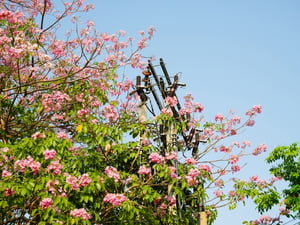Utility Pole Violations (Part 3): Environmental Conditions
 In our 3-part blog series, we are inspecting common pole conditions that can be costly for asset owners, as well as attachers.
In our 3-part blog series, we are inspecting common pole conditions that can be costly for asset owners, as well as attachers.
For our first article, we looked at dangerous conditions on utility poles. The second article examined the multitude of possible damage and violations on poles. Our final article in this series will dive into environmental forces that cause violations on and around poles.
Environmental causes and outside forces can quickly turn assets into liabilities. For example, wooden poles are susceptible to even the smallest forces out-of-doors, like woodpecker holes and insect infestation that cause damage leading to pole degradation.
Watch the video on environmental conditions below.
Environmental conditions can cause problems that lead to lack of public safety, lineworker safety, and asset owner and attacher safety. We’ve outlined a few common environmental violations below.
Insects & Animals
Overgrown Vegetation
Storms
Preparing for Environmental Factors
The key to being storm-prepared and proactive in preventing violations thorough inventories of field assets and excellent record keeping. Why? Inspections help you stay ahead of problems to keep field assets accessible and operating. Inspection data is used to keep on-going management of utility assets running smoothly, while strengthening strong joint use partnerships. Properly trained inventory teams check for and report environmental damage and violations, like insect infestation, bird damage, decay, earth erosion, vegetation concerns, and more.
Staying Organized During an Inventory
Dashboards in a centralized, asset management system let the user know in real-time the status of their current inventory. Users can stay aware of violations found, potential liabilities for environmental damage, and progress on the inventory. Dashboards alert asset owners (based on user preference) about necessary actions to take. They should also know pole basics—height, type, and ground clearance from the lowest attachment.
A centralized asset management system is capable of streamlining communication, storing important documents from inventories, and keeping accurate records through long periods of time. These features help owners and attachers be aware of pole conditions, no matter what the outside condition may be.
How does your joint use management team stay prepared for environmental conditions? Share with us in the comments below.